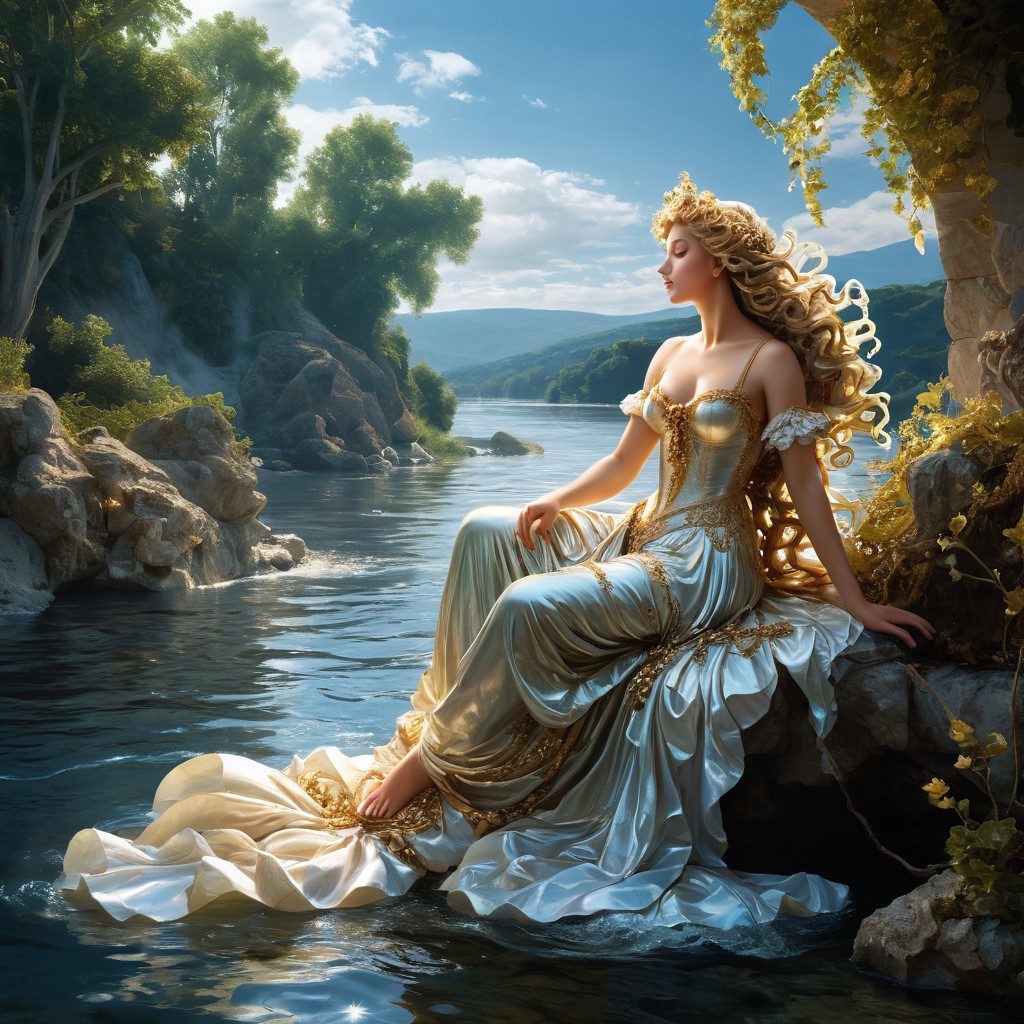Oceanids: The Nymphs of the Seas and Rivers in Greek Mythology

The Oceanids, also known as the daughters of Oceanus and Tethys, are an extensive group of water nymphs in Greek mythology. They personify the countless bodies of water that make up the world, from rivers and springs to seas and clouds. Though they may not be as famous as other divine figures like the Olympian gods or even the more well-known nymphs of the forests, the Oceanids are integral to the mythological world, acting as protectors of nature and often playing supporting roles in the stories of gods and heroes
With over 3,000 Oceanids named in ancient texts, they represent both the vastness and variety of the Earth’s waters, each with her own unique identity and role in mythology. Let’s dive deep into their origins, stories, and how they’ve continued to inspire modern interpretations in literature, art, and media.
Origins and Cultural History of the Oceanids
The Oceanids are the daughters of two primordial deities: Oceanus and Tethys. Oceanus is one of the Titans and the personification of the vast, encircling river believed to surround the world in early Greek cosmology, while Tethys, his sister and consort, is the mother of all the waters. Together, they produced the Oceanids and the Potamoi (river gods), creating a vast family of water deities that governed everything from the smallest spring to the mightiest river.
The sheer number of Oceanids reflects the importance of water to the ancient Greeks. Water was everywhere—crucial for life, agriculture, and travel—and each body of water had its own divine guardian. While some of these Oceanids had specific rivers or lakes associated with them, many were more abstract in their representation of water in general.
The Oceanids weren’t just limited to rivers and seas. They were often connected with clouds, rain, and freshwater sources like springs. Their roles were mostly benevolent, as they were seen as nurturing forces who supported life. However, some Oceanids, like other nymphs, could become dangerous or vengeful if disrespected.
Notable Oceanids in Mythology


Given the vast number of Oceanids, only a few are prominent in myth, but those who do appear often play pivotal roles in the stories of gods and heroes. Here are some of the most notable Oceanids:
1. Styx
Styx is one of the most significant Oceanids, and she personifies the river that separates the world of the living from the underworld. In Greek myth, Styx is also the goddess of oaths. The gods swear by her name, and breaking an oath sworn on the River Styx carries dire consequences. According to Theogony by Hesiod, Styx was the first to side with Zeus during the Titanomachy, the great war between the Olympian gods and the Titans. For her loyalty, Zeus honored her by making her river the most sacred of all.
2. Metis
Metis, another Oceanid, is most famous for being the first wife of Zeus and the mother of Athena. According to myth, Zeus swallowed Metis while she was pregnant with Athena, fearing that their child would be more powerful than him. Metis continued to live inside Zeus, offering him wisdom, and eventually, Athena sprang fully grown from Zeus’s head. Metis is often associated with wisdom and cunning intelligence, and her story reflects the complex relationships between the gods.
3. Eurynome
Eurynome is another important Oceanid, often associated with fertility and creation. In some myths, she is the mother of the Charites (Graces), goddesses of beauty and charm. In a more obscure creation myth from Arcadia, Eurynome is said to have danced on the surface of the sea, shaping the universe with her movements. She is often depicted as a creative and nurturing force, much like the oceans themselves.
4. Clymene
Clymene, sometimes associated with fame and renown, plays a key role in several myths. In some traditions, she is the mother of Phaethon by Helios, the Sun god. Phaethon’s disastrous attempt to drive his father’s chariot across the sky, resulting in his fiery death, is a famous myth about the dangers of hubris. Clymene, as his grieving mother, represents the familial consequences of divine ambitions.
5. Dione
Dione, in some traditions, is considered an Oceanid and is associated with the oracle of Dodona, one of the most ancient religious sites in Greece. In certain myths, she is also regarded as the mother of Aphrodite, the goddess of love, by Zeus, placing her among the most significant figures in Greek mythology.
Role and Representation in Literature and Art
The Oceanids, though not as frequently mentioned as other mythological figures, appear in some of the most important works of ancient literature. Hesiod’s Theogony mentions many Oceanids by name, giving a detailed list of these water nymphs and their attributes. In Homer’s Iliad and Odyssey, Oceanids like Styx and Metis appear as supporting characters, emphasizing their importance in both divine and mortal affairs.
In Greek art, Oceanids are often depicted as graceful women, either alone or in groups, symbolizing their fluid nature as water deities. They are usually shown near water sources, such as rivers or springs, often adorned with aquatic symbols like water jugs, fish, or reeds. The Oceanids are also closely tied to the imagery of rivers and seas, which often feature prominently in depictions of their father, Oceanus.
Their graceful forms and nurturing qualities are reflected in Roman mosaics and frescos as well, where they are often shown in peaceful natural settings, emphasizing their roles as protectors and personifications of natural waters.
Strengths and Weaknesses of the Oceanids
Strengths:
- Guardians of Life: The Oceanids, as water deities, are fundamental to the existence and survival of life. Their presence in rivers, seas, and springs ensures that life continues to thrive. Their connection to life-giving waters makes them powerful symbols of fertility and nature’s bounty.
- Diverse Powers: Each Oceanid has her own unique powers and areas of influence, ranging from clouds and rain to wisdom and fertility. This diversity makes them versatile figures in mythology, capable of playing many different roles, from nurturers to advisors.
- Intermediaries Between Gods and Mortals: Oceanids often act as go-betweens for the gods and humans. Their roles as water nymphs make them accessible and approachable, unlike the more distant Olympians. They assist heroes, protect natural landscapes, and intervene in divine matters.
- Loyal and Resourceful: Oceanids like Styx and Metis demonstrate their loyalty to the Olympian gods, especially in the Titanomachy, and play key roles in shaping the outcome of critical mythological events. Their resourcefulness, as shown by Metis’s cunning, showcases their intelligence and strategic minds.
Weaknesses:
- Vulnerability to Gods’ Manipulation: Despite their powers, the Oceanids are often at the mercy of the Olympian gods. Metis’s fate, for instance, shows how even an Oceanid can be subject to manipulation and control by the more powerful Olympians, highlighting their vulnerability.
- Limited Autonomy: As daughters of Oceanus and Tethys, the Oceanids are often bound to their elemental roles. Their identities and actions are usually tied to specific bodies of water or natural phenomena, which can limit their autonomy in the larger pantheon.
- Understated Influence: While the Oceanids have many powers, they are often overshadowed by the more famous gods and goddesses of Greek mythology. Their roles are usually secondary, supporting characters to more prominent deities and heroes, which limits their visibility in myth.
Oceanids in Modern Media
Although the Oceanids do not appear as often in modern retellings of Greek mythology as figures like Zeus or Athena, they have a subtle but enduring presence in literature, film, and games. Their connection to nature, water, and feminine power has inspired new interpretations of their myth.
- Literature:
- The Oceanids appear in various retellings of Greek myths, such as The Song of Achilles by Madeline Miller, where figures like Thetis (though technically a Nereid, another group of sea nymphs) evoke the broader theme of water nymphs. Many authors who draw on Greek mythological themes include Oceanid-like characters to represent the nurturing yet wild aspect of nature.
- Video Games:
- In games like Hades (2020), which reimagines Greek mythology in a modern rogue-like setting, characters inspired by water nymphs, including Oceanids, make appearances. The game captures the diverse pantheon of Greek gods and deities, with the Oceanids serving as lesser-known but important elements in the mythological landscape.
- Film and Television:
- Oceanid-like characters appear in adaptations of Greek mythology on screen, though often amalgamated into broader depictions of nymphs or nature spirits. In Percy Jackson & the Olympians, the world of Greek gods and demigods includes water nymphs, who echo the traits and roles of the Oceanids.
The Oceanids: Symbols of Nature’s Grace and Power
Though less famous than their Olympian counterparts, the Oceanids remain vital to the world of Greek mythology. They embody the life-giving and nurturing aspects of water, from springs and rivers to oceans and clouds. These deities are symbols of the natural world’s
beauty and strength, often stepping in to aid gods and heroes or safeguard the delicate balance of nature.
The Oceanids continue to inspire modern artists and storytellers, serving as reminders of the essential role that nature—and its guardian spirits—play in myth and reality. They are timeless symbols of the powerful, graceful, and ever-present forces of water that shape both the physical and mythical worlds.
